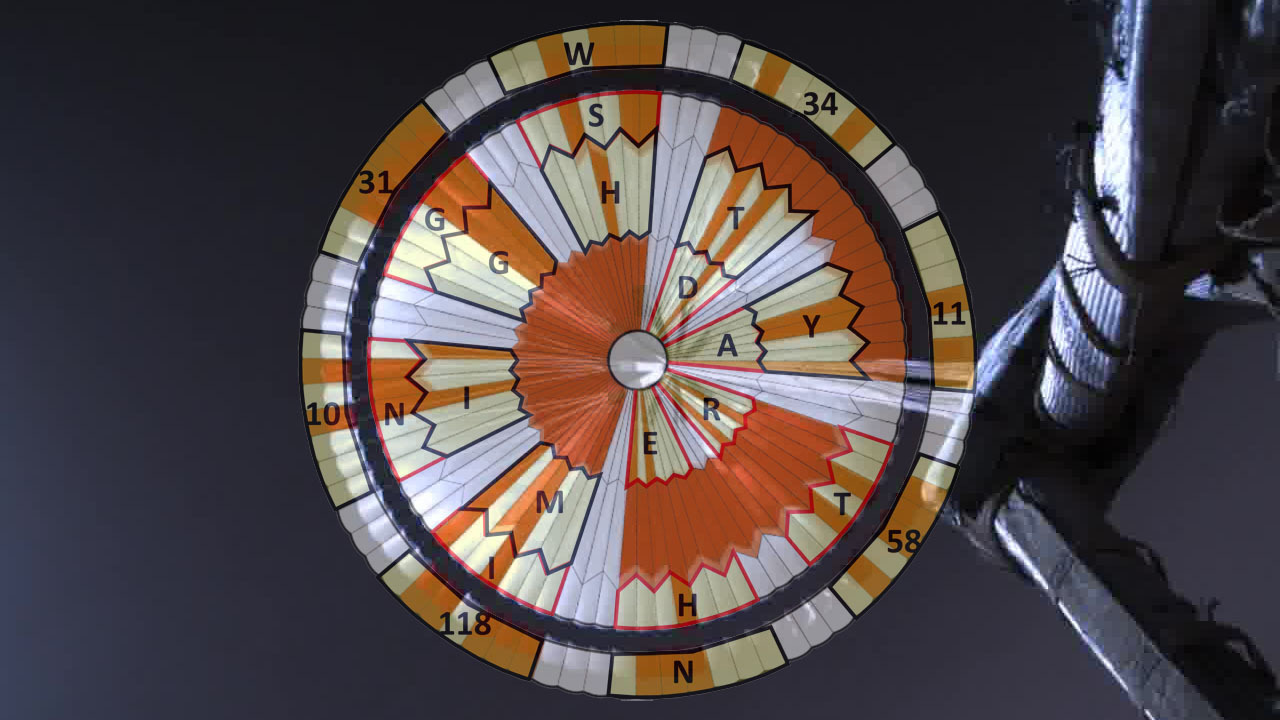Internet sleuths solve secret message on Perseverance rover's Mars parachute
Internet sleuths solved it in 6 hours!

NASA hid a secret message on the parachute that landed its Perseverance rover down on the surface of Mars last week.
Internet sleuths claim to have "cracked a code" hidden in images from the Mars rover's landing last week. Colored patterns in the parachute used for landing appears to have been secretly inscribed with the phrase "Dare mighty things," a motto used by the Perseverance team at NASA's Jet Propulsion Laboratory (JPL) in Pasadena, California, which serves as mission control for the Perseverance rover mission. Also embedded in the message are the geographic coordinates for JPL: 34°11'58" N 118°10'31" W.
Epic video: Watch the Perseverance rover land on Mars
Live updates: NASA's Perseverance Mars rover mission
"dare mighty things" ! Well done! @NASA @NASAPersevere pic.twitter.com/Di1hkFQApdFebruary 22, 2021
During a news briefing on Monday (Feb. 22), NASA revealed the first video taken by Perseverance as it descended to and landed on the Martian surface Feb. 18. Those watching may have noticed a distinct red and white pattern on the interior of the parachute. Allen Chen, the entry, descent and landing lead for the mission confirmed in the briefing that there was a hidden message, and he dared the public to decode it.

"In addition to enabling incredible science, we hope our efforts in our engineering can inspire others," Chen said during the briefing. "Sometimes we leave messages in our work for others to find for that purpose, so we invite you all to give it a shot and show your work."
The rover might even be hiding other secret messages, in addition to the team motto on the parachute, Chen told The Verge. "People can't resist putting a little personal touch in their work … But the vast majority of these will never be known — even by me," he said.
Related: 5 weird things the Perseverance rover took to Mars
Get the Space.com Newsletter
Breaking space news, the latest updates on rocket launches, skywatching events and more!
So, how does a seemingly normal-looking parachute hide such a message? Well, using different shapes and patterns on the parachute fabric to represent different numbers, the team at NASA was able to display the messages in binary computer code, according to the Verge.
Depending on the shape and location of the red-and-white color patterns patterns circling around the parachute's center, the segments represent different numbers which can be translated through binary code. Incredibly, people on the internet cracked the code just a few hours after NASA released the video showing the rover landing.
"It looks like the internet has cracked the code in something like 6 hours! Oh internet is there anything you can't do?" NASA Perseverance chief engineer Adam Steltzner tweeted about the impressive code-cracking.
It looks like the internet has cracked the code in something like 6 hours! Oh internet is there anything you can’t do? For those who just want to know: #Mars2020 #CountdownToMars pic.twitter.com/yTJCEnbuLYFebruary 23, 2021
This isn't the first time that JPL engineers have snuck a secret message onto another planet.
Tiny holes dotted the hollow, aluminum wheels of the agency's Curiosity rover, which landed on Mars in 2012 and continues to explore the Red Planet to this day. These holes served an important purpose by allowing Martian pebbles to fall through instead of getting trapped in the vehicle's wheels, but the holes also spelled out a secret message: "JPL" in Morse code. So, as the rover drives around the surface of Mars it imprints "JPL" in Morse code into the Martian terrain as it goes.
Email Chelsea Gohd at cgohd@space.com or follow her on Twitter @chelsea_gohd. Follow us on Twitter @Spacedotcom and on Facebook.
Join our Space Forums to keep talking space on the latest missions, night sky and more! And if you have a news tip, correction or comment, let us know at: community@space.com.

Chelsea “Foxanne” Gohd joined Space.com in 2018 and is now a Senior Writer, writing about everything from climate change to planetary science and human spaceflight in both articles and on-camera in videos. With a degree in Public Health and biological sciences, Chelsea has written and worked for institutions including the American Museum of Natural History, Scientific American, Discover Magazine Blog, Astronomy Magazine and Live Science. When not writing, editing or filming something space-y, Chelsea "Foxanne" Gohd is writing music and performing as Foxanne, even launching a song to space in 2021 with Inspiration4. You can follow her on Twitter @chelsea_gohd and @foxannemusic.









